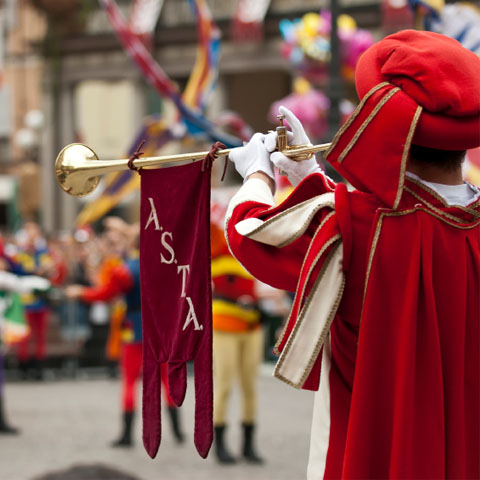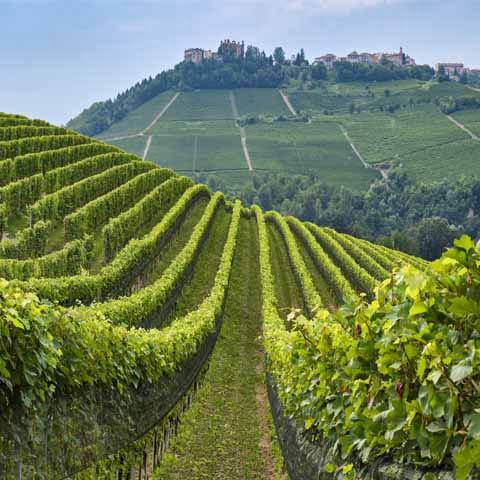Asti is home to nearly 80,000 people and is located in the northwestern region of Piedmont. The city is the capital of the province of the same name and the modern capital of the Monferrato geographic area. Located along the Tanaro River, the city is not far from the foothills of the Alps.
It was the city’s location – one that was ideal for trade route strategies – that helped bring Asti to economic power. While Asti was once under Roman control, much of its most significant history dates to the twelfth century, when it was first beginning to develop as a republic. Throughout the thirteenth and fourteenth centuries, it was passed between various European powers. And it was during the thirteenth century when the town’s famous towers – nearly 150 – were constructed.
Today, the city is characterized by the towers and other historic structures such as churches, palaces, and more, which occupy the town. For travelers looking to explore culture, history, art, and architecture, Asti is a treasure trove of unique sightseeing.
Walking throughout the city of Asti is like traveling through time. The eighteenth-century town squares, narrow streets, and cobblestone walkways are reflective of the rich history of the town.
Travelers to Asti can enjoy a variety of activities, including visiting historic museums, a stunning cathedral, ancient monuments, and many churches. In addition, Asti is known for its incredible array of festivals and events that take over the city throughout the year.
A mid-size city, Asti features many restaurants, bars, cafés, and shops at which travelers can take a break from sightseeing. Not far from Turin, the regional capital of Piedmont, visitors to Asti can also explore nearby sites.
The economy of Asti is based on its culinary and winemaking offerings, including famous DOC and DOCG wines, fruit, vegetables, meat, and truffle production. The Piedmont region as a whole is renowned for its cuisine, and Asti is considered to be one of the gastronomic gems of the area. The city also has lively textile and engineering industries.
GEOGRAPHY & CLIMATE
Asti is located in the Piedmont region of Northern Italy. It is about 34 miles east of Turin and sits on the plains of the Tanaro River.
The climate of Asti is best described as continental, featuring winters that are fairly warm and summers that are mild, with average temperatures ranging from 40° Fahrenheit in the winter to 85° Fahrenheit in the summer. These favorable temperatures are a result of Asti’s proximity to the Mediterranean Sea. Travelers can expect to experience rain mostly during the fall and spring. The minimal rain that does occur in summer comes in the form of brief, heavy thunderstorms. As in other parts of Northern Italy, fog should be expected during the winter.
WHEN IN ASTI
Enjoy the area’s famed wines. Due to the geography and climate of the region, excellent quality grapes are grown there, yielding amazing wines. Piedmont is one of Italy’s best wine producing regions, and Asti in particular, is known for its delicious sparkling varieties. Known as the “champagne of Italy,” Asti Spumante features a high alcohol content, an excellent effervescence, and a sweet flavor. Another of the area’s renowned sparkling wines is Moscato d’Asti, known for being a wonderful dessert wine. In addition to white wines, the area features full-bodied reds such as Barbera d’Asti, Grignolino d’Asti, Freisa d’Asti, and more. Without a doubt, Asti is a true haven for wine lovers.
Indulge in the region’s hearty cuisine. Known for its rich, earthy flavors, the cuisine of Asti is comprised of stuffed pasta such as agnolotti, rich courses of roasted or boiled meats, locally made DOP cheeses, and delicious desserts like hazelnut cakes and Italian cookies. In addition, the region of Piedmont is known for its truffles, which are featured in a variety of ways throughout meals in Asti, most often shaved atop decadent pasta and meat dishes.
Sightsee the city’s medieval towers. Known as the “City of a Hundred Towers,” Asti is home to a variety of unique, ancient towers that are perfect for sightseeing. In the historic city center, travelers can see the Torre Comentina and Torre Troyana. The latter is one of the main symbols of the city. Standing at approximately 144 feet, Torre Troyana is the tallest tower in the Piedmont region, and it offers the most remarkable views of Asti and the surrounding area. Additionally, at the Church of Santa Caterina, there is the Torre Romana, a tower that now serves as the church’s bell tower.
Experience the local culture by taking part in local events and festivals. Asti features many exciting and unique events throughout the year, including the Palio d’Asti – a horserace which has become such a tradition that hundreds of thousands of people flock to it each year. Another must-see event is the “Festival of Festivals,” which is a celebratory festival held before the palio that features local food, wine, and a parade with ornate floats. During the event, the largest open-air restaurant in Italy is created and attendees can taste wine and food from dozens of vendors. In November, Asti celebrates the truffle with the Regional Truffle Festival. Ideal for foodies, the festival offers tastings, the opportunity to purchase the rare ingredient, and more.
Gaze upon the wonderful architecture of Asti. From the Cathedral of Santa Maria Assunta, a stunning thirteenth-century church with Romanesque-Gothic details, to Palazzo Mazzetti, an eighteenth-century palace that also contains a Roman artifact museum, there is an abundance of gorgeous architecture to be experienced in Asti.
Asti may be best known for its food and wine, yet this charming city is also home to a remarkable number of cultural sights. From the medieval towers to the ornate churches and the legendary Palio d’Asti tradition, the city of Asti is full of surprises that delight travelers of all interests.
Travel Guides
The Piedmont Region of Italy
The Cities of Piedmont, Italy






